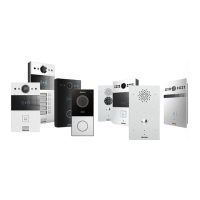
Do you have a question about the Akuvox R20A Series and is the answer not in the manual?
| Installation | Wall-mounted |
|---|---|
| Protection level | IP65 |
| RS485 | Yes |
| Camera | 2MP |
| Audio | Built-in microphone and speaker |
| Network | 10/100Mbps Ethernet |
| Protocols | SIP, RTSP |
| Power | PoE or 12V DC |
Describes methods to find the device's IP address using its button or an IP scanner tool.
Guides users on logging into the device's web interface for configuration and parameter adjustment.
Explains how to check network status and configure basic IP settings like DHCP or static IP.
Details how to configure Wi-Fi connections for the door phone, including scanning and authentication.
Explains how to set up and make direct IP calls and SIP calls for intercom communication.
Guides on registering up to two SIP accounts for intercom functionality, including account details.
Explains supported audio codecs (PCMU, PCMA, G729, G722) for call sessions, detailing bandwidth and sample rates.
Describes video codec options like H.264, resolution, and bitrate for optimizing video quality.
Selects card code formats (IC, ID, Wiegand) to match third-party systems for RF card door access.
Enables remote door unlocking via HTTP commands by configuring the device's URL and credentials.
Configures tamper alarm sensitivity and motion detection parameters for device security and surveillance.
Sets up email, FTP, SIP call, and HTTP URL notifications for triggered security events.
Enables and configures RTSP streams for real-time audio/video monitoring from the door phone.
Allows capturing of MJPEG format monitoring images and setting image quality parameters.
Manages device logs (event, system) for debugging, allowing export to remote servers.
Utilizes PCAP to capture data packets for network debugging and troubleshooting purposes.
Explains the concept of auto-provisioning, its protocols, and configuration file formats.
Details scheduling options for auto-provisioning, PNP configuration, and static provisioning methods.
Guides on integrating the door phone with third-party devices using the Wiegand interface.
Explains how to achieve network-based integration using the HTTP API with third-party devices.
Describes the process of changing the default web interface password for administrator and user accounts.
Sets up automatic logout from the web interface after a period of inactivity to enhance security.
Explains how to restart the device system through the web interface.
Guides users on resetting the device to its original factory default settings.